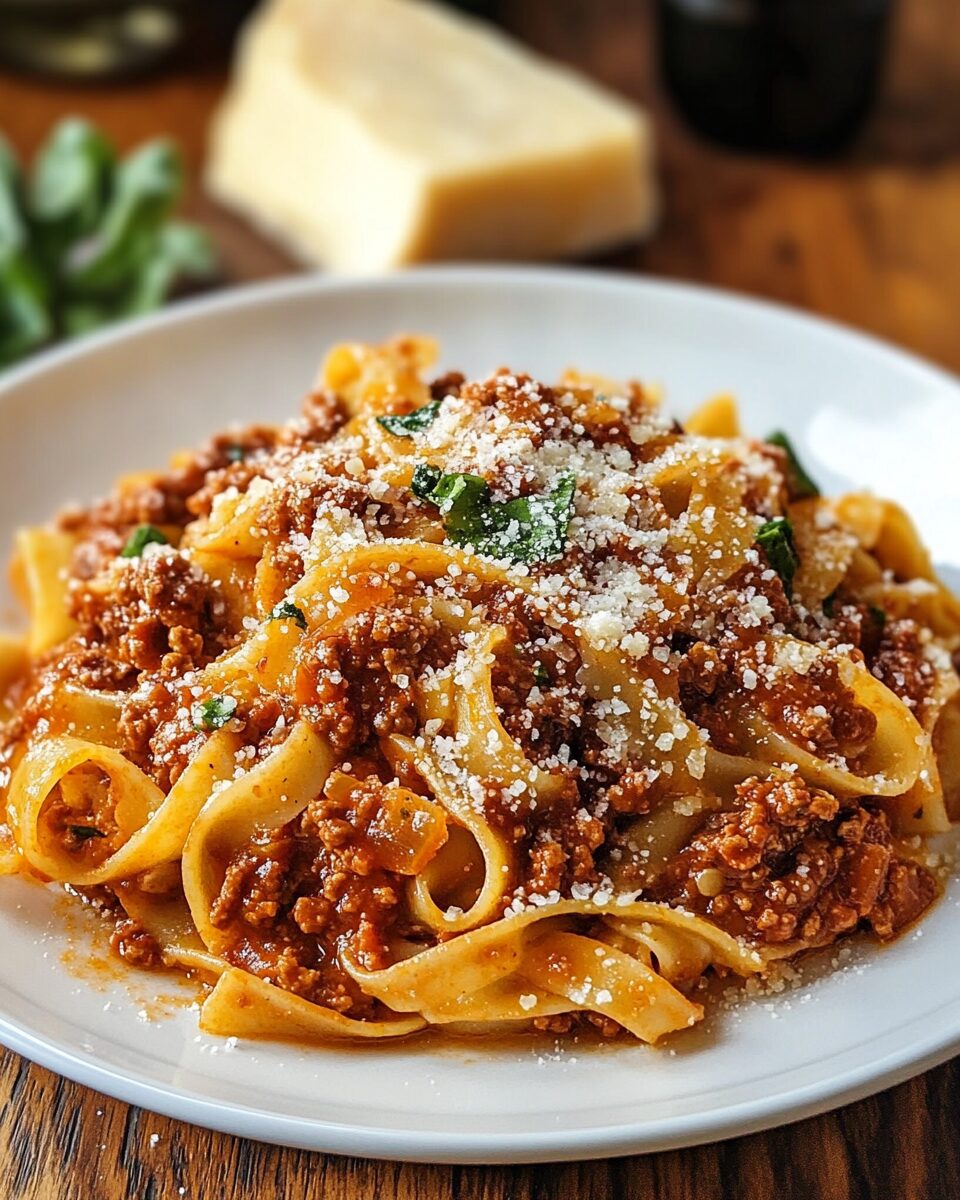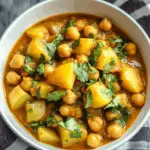This Tuscan Ragu is a rich, slow-cooked meat sauce featuring a flavorful combination of ground beef, pork sausage, and a hearty tomato base. It’s the kind of dish that brings the rustic flavors of Tuscany right to your table, perfect for pairing with wide, thick pappardelle or even hand-rolled pici pasta. With the addition of rosemary, garlic, and a splash of red wine, the sauce develops layers of flavor over a gentle simmer, making it a perfect comfort meal for any occasion. The deep, meaty sauce clings beautifully to the pasta, providing a hearty, satisfying bite in every forkful.
Full recipe:
Ingredients:
-
- 2 tbsp olive oil
- 1 onion, chopped
- 2 ribs celery, diced
- 2 carrots, chopped
- 3 cloves garlic, minced
- 1 sprig rosemary (leaves only), chopped
- 2 lbs ground beef
- 1 lb pork sausage (casing removed)
- 250 ml (1 cup) dry red wine
- 400 g (14 oz) canned chopped tomatoes
- 500 ml (17.5 oz) tomato passata
- 3 tbsp tomato paste
- Salt and pepper to taste
Directions:
- Heat olive oil in a large, deep frying pan or Dutch oven over medium heat.
- Add the onion, celery, carrots, garlic, and rosemary. Cook on low heat for 10 minutes until softened, but not browned.
- Add the ground beef and pork sausage, breaking them up with a spatula, and cook until browned and no longer pink.
- Pour in the red wine and cook for 10 minutes, allowing it to reduce.
- Add the chopped tomatoes, passata, tomato paste, and a pinch of salt and pepper. Bring to a simmer.
- Lower the heat, cover the pan, and cook for 1.5 to 2 hours, stirring occasionally. Add water if the sauce thickens too much.
- Taste and adjust seasoning as needed. Serve over pasta, preferably pappardelle or hand-rolled pici.
Prep Time: 20 minutes | Cooking Time: 2 hours | Total Time: 2 hours 20 minutes
Calories: 338 kcal | Servings: 10 servings
The Rich History of Tuscan Ragu
Tuscan Ragu is one of those recipes that feels like a comforting embrace, combining hearty, bold flavors with the warm tradition of slow-cooking. Its roots trace back to Tuscany, a region renowned for its rustic, earthy cuisine. Italian food is deeply regional, and while many people are familiar with Bolognese, originating from Bologna, Tuscan Ragu offers a unique take on the classic “meat sauce” (or ragu in Italian), featuring local flavors and traditions that set it apart.
While both Bolognese and Tuscan Ragu are ragù di carne (meat sauces), the Tuscan version emphasizes the use of local ingredients such as pork sausage, rosemary, and red wine. The inclusion of sausage, rather than just ground beef, adds a layer of richness and complexity to the sauce, making it distinctly Tuscan. Tuscany is famous for its cured meats and sausages, and this ragu reflects the region’s agricultural bounty, where hearty, flavorful dishes have been passed down through generations.
Why Tuscan Ragu is Special
What sets Tuscan Ragu apart from other ragu sauces is its simplicity paired with depth of flavor. Many traditional Italian recipes focus on showcasing high-quality ingredients in an uncomplicated way, allowing their natural flavors to shine. Tuscan Ragu exemplifies this perfectly, with its minimal ingredient list that yields a surprisingly complex and satisfying sauce.
Key elements like the soffritto (a mix of slow-fried onions, celery, and carrots), fresh rosemary, and a generous splash of red wine all work together to create layers of flavor that develop over time. The result is a robust, meaty sauce that balances acidity, sweetness, and savory notes. The secret is in the slow simmer – allowing the sauce to cook for 1.5 to 2 hours ensures that all the ingredients meld together, creating a rich and aromatic dish.
The Importance of Soffritto
The soffritto base is essential to many Italian dishes, including Tuscan Ragu. Slowly cooking the onion, carrot, and celery trio releases their natural sweetness and depth, infusing the oil with flavors that serve as the backbone of the sauce. This “holy trinity” of Italian cooking is an often-overlooked technique that brings a subtle but important layer of complexity to the dish. When combined with garlic and fresh rosemary, it sets the stage for a deep and satisfying sauce.
The Benefits of Cooking Tuscan Ragu
1. Versatility: One of the best things about Tuscan Ragu is its versatility. While it pairs beautifully with traditional Tuscan pastas like pappardelle or pici, it can be used in various other dishes. Whether spooned over creamy polenta, layered in lasagna, or served atop roasted spaghetti squash for a low-carb twist, this sauce works well with numerous accompaniments.
In addition, Tuscan Ragu freezes exceptionally well. If you make a large batch, you can easily store leftovers in the freezer for up to six months. This makes it a perfect meal prep option, ensuring you always have a rich, homemade sauce ready to go for busy weeknights.
2. Nutritional Value: While this ragu is definitely a hearty dish, it also offers a surprising amount of nutritional benefits. Ground beef provides a substantial amount of protein, iron, and B vitamins, all of which are crucial for maintaining energy levels and muscle health. Pork sausage adds additional protein and fat, making the dish a satiating meal that keeps you full for longer.
The soffritto base brings in a host of vitamins and minerals as well. Carrots are a great source of beta carotene, an antioxidant that is vital for maintaining healthy skin and vision. Celery contributes vitamins A and K, as well as fiber, which aids digestion. Onions and garlic are well-known for their immune-boosting properties, making this dish as healthy as it is delicious.
Lastly, red wine – used to deglaze the pan and simmer with the sauce – not only enhances the flavor but also offers antioxidants, most notably resveratrol, which has been linked to heart health.
3. Economical and Sustainable: The ingredients in Tuscan Ragu are simple and affordable, making it an economical choice for feeding a large family or preparing meals for the week. Using ground beef and pork sausage ensures that the dish is rich and hearty without requiring expensive cuts of meat. You can also use seasonal vegetables and locally sourced ingredients, which is not only better for the environment but also ensures fresher, more flavorful results.
Additionally, making a large pot of ragu in one go and freezing portions reduces waste, as you’re less likely to throw out unused ingredients.
Cooking Techniques that Elevate the Recipe
1. Slow Cooking: The most important technique in this recipe is patience. A ragu sauce must be simmered slowly to allow all the flavors to come together. The low heat and long cooking time break down the fats and fibers in the meat, infusing the sauce with a meaty richness that can’t be achieved through quick cooking.
2. Deglazing with Red Wine: Red wine is a crucial component of Tuscan Ragu, as it deglazes the pan after browning the meat. This technique lifts all the flavorful bits stuck to the bottom of the pan, ensuring nothing is wasted. The wine also adds acidity and a depth of flavor that balances the sweetness of the tomatoes. The alcohol evaporates during cooking, leaving behind a rich, slightly fruity undertone.
3. Balancing the Tomatoes: The combination of canned chopped tomatoes, tomato passata (pureed tomatoes), and tomato paste provides the perfect balance of sweetness and acidity in the sauce. The passata adds a smooth texture, while the chopped tomatoes give the sauce body. The tomato paste, concentrated and flavorful, deepens the color and intensity of the sauce, giving it a luxurious mouthfeel.
Why This Recipe is the Best
Tuscan Ragu is more than just a sauce; it’s a reflection of Tuscany’s culinary philosophy – fresh, seasonal, and flavorful ingredients cooked with care. This recipe captures the essence of Italian comfort food, offering a perfect balance of meatiness, sweetness, and herbaceous notes. Its ability to pair well with various types of pasta, or even non-traditional options like polenta, makes it a flexible choice for cooks of all levels.
Moreover, its simplicity means that even beginner cooks can tackle this recipe with ease, while more experienced chefs can enjoy the process of slow-cooking and tweaking flavors to their preference. The use of readily available ingredients also makes it a dish that anyone can prepare, regardless of where they are in the world.
Conclusion
Tuscan Ragu is a deeply satisfying dish that brings the warmth and tradition of Italian cooking to your kitchen. Whether you’re hosting a family dinner or simply want to enjoy a comforting meal, this sauce will deliver bold flavors and a sense of connection to the rustic heart of Tuscany.






